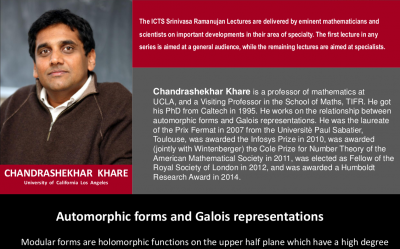Modular forms are holomorphic functions on the upper half plane which have a high degree of symmetry. Galois theory studies permutation symmetries of roots of polynomial equations defined over the rationals. There is a close and occult connection between these two completely different symmetries. This lecture series will explore this connection, putting special emphasis on the case when the group of symmetries of the roots of the polynomial is the group of two by two invertible matrices over a finite field.
Lecture 1: Modular forms and Galois representations
Abstract: This will be a broad overview of the connection between Galois groups and modular forms, and reciprocity laws in this context which link the two. One such law is Serre's modularity conjecture which has the particular consequence that there is a unique, irreducible, odd motive of rank 2 over the rationals, of weight 12 and with good reduction everywhere. It arises from the Ramanujan Delta-function.
Date: 3 November 2014
Time: 11:30 to 12:30
Venue: AG 66
Lecture 2: Automorphy lifting theorems
Abstract: This lecture will talk about a technique used in the proof of Serre's modularity conjecture. This technique, called modularity/automorphy lifting, was developed by Wiles in his proof of Fermat's Last Theorem. It allows one to go "backwards" from a Galois representation to a modular form. (The "forward" direction from modular forms to Galois representations was known earlier by the work of Eichler, Shimura, Deligne and Serre.) Its likelyto be a key tool in any attack on higher dimensional analogs of Serre's conjecture.
Date: 5 November 2014
Time: 11:30 to 12:30
Venue: AG 66
Lecture 3: Dimensions of deformation rings and generic unobstructedness
Abstract: This lecture will talk about deformation rings of Galois representations as defined by Barry Mazur. Their spectra are moduli spaces of Galois representations. These moduli spaces provides a context for the study of a classical conjecture of Leopoldt. I will indicate how automorphy lifting techniques give rather complete information about these moduli spaces in the self-dual case, while in the non-self-dual case, the corresponding moduli spaces are still shrouded in mystery. It is the latter case which is relevant to Leopoldt's conjecture which postulates a dimension formula for these spaces.
Schedule for the lecture series
11.00 Tea/Coffee
11.30 Srinivasa Ramanujan Lecture


